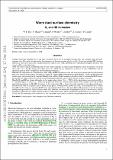Files in this item
Warm dust surface chemistry : H2 and HD formation
Item metadata
| dc.contributor.author | Thi, W. F. | |
| dc.contributor.author | Hocuk, S. | |
| dc.contributor.author | Kamp, I. | |
| dc.contributor.author | Woitke, P. | |
| dc.contributor.author | Rab, Ch | |
| dc.contributor.author | Cazaux, S. | |
| dc.contributor.author | Caselli, P. | |
| dc.date.accessioned | 2019-05-03T08:30:04Z | |
| dc.date.available | 2019-05-03T08:30:04Z | |
| dc.date.issued | 2020-02 | |
| dc.identifier | 258237686 | |
| dc.identifier | f71d1350-2982-44e1-b977-48985c7e3620 | |
| dc.identifier | 000513143700001 | |
| dc.identifier | 85088116323 | |
| dc.identifier.citation | Thi , W F , Hocuk , S , Kamp , I , Woitke , P , Rab , C , Cazaux , S & Caselli , P 2020 , ' Warm dust surface chemistry : H 2 and HD formation ' , Astronomy & Astrophysics , vol. 634 , A42 . https://doi.org/10.1051/0004-6361/201731746 | en |
| dc.identifier.issn | 0004-6361 | |
| dc.identifier.other | ArXiv: http://arxiv.org/abs/1812.06730v1 | |
| dc.identifier.uri | https://hdl.handle.net/10023/17636 | |
| dc.description | Funding: EU FP7- 2011 under Grant Agreement nr. 284405 (IK, WFT, CR, and PW). | en |
| dc.description.abstract | Context. Molecular hydrogen (H2) is the main constituent of the gas in the planet-forming disks that surround many pre-main-sequence stars. H2 can be incorporated in the atmosphere of the nascent giant planets in disks. Deuterium hydride (HD) has been detected in a few disks and can be considered the most reliable tracer of H2, provided that its abundance throughout the disks with respect to H2 is well understood. Aims. We wish to form H2 and HD efficiently for the varied conditions encountered in protoplanetary disks: the densities vary from 104 to 1016 cm−3; the dust temperatures range from 5 to 1500 K, the gas temperatures go from 5 to a few 1000 Kelvin, and the ultraviolet radiation field can be 107 stronger than the standard interstellar field. Methods. We implemented a comprehensive model of H2 and HD formation on cold and warm grain surfaces and via hydrogenated polycyclic aromatic hydrocarbons in the physico-chemical code PROtoplanetary DIsk MOdel. The H2 and HD formation on dust grains can proceed via the Langmuir-Hinshelwood and Eley-Ridel mechanisms for physisorbed or chemisorbed H (D) atoms. H2 and HD also form by H (D) abstraction from hydrogenated neutral and ionised PAHs and via gas phase reactions. Results. H2 and HD are formed efficiently on dust grain surfaces from 10 to ~700 K. All the deuterium is converted into HD in UV shielded regions as soon as H2 is formed by gas-phase D abstraction reactions. The detailed model compares well with standard analytical prescriptions for H2 (HD) formation. At low temperature, H2 is formed from the encounter of two physisorbed atoms. HD molecules form on the grain surfaces and in the gas-phase. At temperatures greater than 20 K, the encounter between a weakly bound H- (or D-) atom or a gas-phase H (D) atom and a chemisorbed atom is the most efficient H2 formation route. H2 formation through hydrogenated PAHs alone is efficient above 80 K. However, the contribution of hydrogenated PAHs to the overall H2 and HD formation is relatively low if chemisorption on silicate is taken into account and if a small hydrogen abstraction cross-section is used. The H2 and HD warm grain surface network is a first step in the construction of a network of high-temperature surface reactions. | |
| dc.format.extent | 1030131 | |
| dc.language.iso | eng | |
| dc.relation.ispartof | Astronomy & Astrophysics | en |
| dc.subject | Astrochemistry | en |
| dc.subject | Molecular processes | en |
| dc.subject | Methods: numerical | en |
| dc.subject | QB Astronomy | en |
| dc.subject | QC Physics | en |
| dc.subject | QD Chemistry | en |
| dc.subject | 3rd-DAS | en |
| dc.subject.lcc | QB | en |
| dc.subject.lcc | QC | en |
| dc.subject.lcc | QD | en |
| dc.title | Warm dust surface chemistry : H2 and HD formation | en |
| dc.type | Journal article | en |
| dc.contributor.sponsor | European Commission | en |
| dc.contributor.institution | University of St Andrews. School of Physics and Astronomy | en |
| dc.contributor.institution | University of St Andrews. St Andrews Centre for Exoplanet Science | en |
| dc.identifier.doi | 10.1051/0004-6361/201731746 | |
| dc.description.status | Peer reviewed | en |
| dc.identifier.url | http://arxiv.org/abs/1812.06730v1 | en |
| dc.identifier.grantnumber | 284405 | en |
This item appears in the following Collection(s)
Items in the St Andrews Research Repository are protected by copyright, with all rights reserved, unless otherwise indicated.

